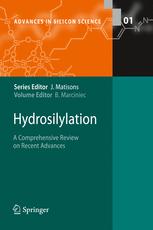

Most ebook files are in PDF format, so you can easily read them using various software such as Foxit Reader or directly on the Google Chrome browser.
Some ebook files are released by publishers in other formats such as .awz, .mobi, .epub, .fb2, etc. You may need to install specific software to read these formats on mobile/PC, such as Calibre.
Please read the tutorial at this link: https://ebookbell.com/faq
We offer FREE conversion to the popular formats you request; however, this may take some time. Therefore, right after payment, please email us, and we will try to provide the service as quickly as possible.
For some exceptional file formats or broken links (if any), please refrain from opening any disputes. Instead, email us first, and we will try to assist within a maximum of 6 hours.
EbookBell Team

5.0
40 reviewsFor fifty years, Hydrosilylation has been one of the most fundamental and elegant methods for the laboratory and industrial synthesis of organosilicon and silicon related compounds. Despite the intensive research and continued interest generated by organosilicon compounds, no comprehensive book incorporating the various aspects of Hydrosilylation has been published this century.
The aim of Hydrosilylation is to comprehensively review the advances of hydrosilylation processes since 1990. The survey of the literature published over the last two decades, including ca 2000 articles, patents and reviews, enables the authors to discuss the most recent aspects of hydrosilylation advances, (i.e. catalytic and synthetic) as well as to elucidate the reaction mechanism for the given catalyst used and the reaction utilization. New catalytic pathways under optimum conditions necessary for efficient synthesis of organosilicon compounds are presented. The key point of this monograph is to show extensive development in the application of hydrosilylation in organic and asymmetric syntheses as well as in polymer and material science.
Hydrosilylation is the definitive monograph in the area written for reseachers and industrial chemists involved in silicon chemistry, organic synthetic chemists with an interest in silicones, silane coupling agents and hybrid inorganic-organic materials; as well as researchers working on organosilicon reagents in organic and polymer chemistry. Finally, this book provides an excellent review of hydrosilylation processes and their products thus making this book a useful handbook for post-graduate students working in catalysis, organometallic chemistry as well as synthesis and the technology of fine chemicals.